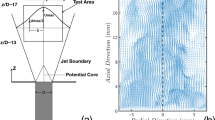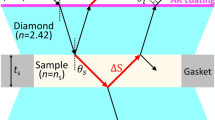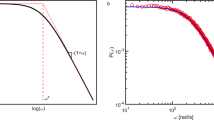Abstract
Birchoff and Cagwood1 have described a method for the measurement of velocity distributions in liquids using a sheet of equally spaced rising air bubbles. These are photographed against a dark background, with flash-tube illumination, using the light scattered from the air bubbles; two exposures are recorded on the same plate from two flashes at a known interval apart. Relf2 has used oil drops dispersed in water, illuminated by an arc lamp, to measure fluid velocity. The drops appear as bright points, and thus a time exposure enables the fluid velocity to be found.
This is a preview of subscription content, access via your institution
Access options
Subscribe to this journal
Receive 51 print issues and online access
$199.00 per year
only $3.90 per issue
Buy this article
- Purchase on Springer Link
- Instant access to full article PDF
Prices may be subject to local taxes which are calculated during checkout
Similar content being viewed by others
References
Birchoff, G., and Cagwood, J. E., J. App. Phys., 20, 646 (1949).
Relf, E. F., Advis. Comm. Aero., Reports and Memoranda No. 76 (1913).
Goldstein, S., “Modern Developments in Fluid Dynamics”, 1, 304 (Oxf. Univ. Press, 1938).
Author information
Authors and Affiliations
Rights and permissions
About this article
Cite this article
CAFFYN, J., UNDERWOOD, R. An Improved Method for the Measurement of the Velocity Profiles in Liquids. Nature 169, 239–240 (1952). https://doi.org/10.1038/169239a0
Issue Date:
DOI: https://doi.org/10.1038/169239a0
This article is cited by
-
A method for automatic particle tracking in a three-dimensional flow field
Experiments in Fluids (1988)
Comments
By submitting a comment you agree to abide by our Terms and Community Guidelines. If you find something abusive or that does not comply with our terms or guidelines please flag it as inappropriate.



